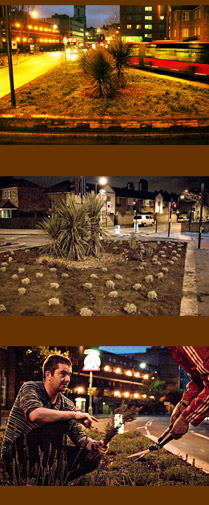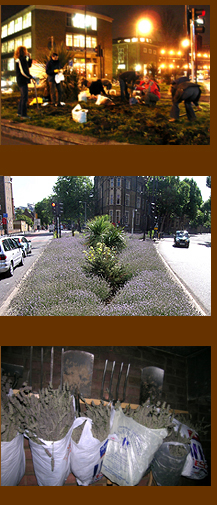FAST COMPOSTING—In 21 Days—Really!
An Alternative to Backbreaking Work!
by Fred Davis, MG, MC, Hill Gardens of Maine (To view previous articles, click: Archives) (This information was taken from the downloadable book, "Keys To The Garden Gate" on this site)
Most of the old-fashioned composting methods are actually labor intensive and often a little too slow for my taste and purposes. The pile must be turned to re-introduce air into colonies of oxygen-starved bacteria, fungi and other organisms. There is an easier way which incorporates very nearly all basic composting principles but which vastly improves on two crucial factors: aeration and time.
Here's my system for producing finished "black gold"—fully decomposed, rich, dark, nutrient-saturated, weed- and disease-free organic matter ready to be worked into garden soil—in 21 to 28 days, with no turning!
The Enclosure. A diversity of materials may be used for the enclosure—concrete blocks, timbers, wire mesh or boards, for example—but for economy's sake, I have constructed my "no-turn, self-aerating, 3-week" compost bin from salvaged pallets commonly used by truckers in the transport of equipment or supplies. Other sources of these used—oftentimes perfectly usable—pallets are large hardware stores, plumbing/heating suppliers, lumber yards...and don't overlook your local landfill or waste transfer station. A friend or neighbor who works at large discount stores or on construction sites may be of some help, too. As interest in using recycled or salvageable pallets increases, it is likely that you may have to pay for them. $5 would not be an unreasonable amount for sound, fully-intact pallets. Most medium-to-full-size automobiles are wide enough in the trunk to accommodate one or two pallets.
commonly used by truckers in the transport of equipment or supplies. Other sources of these used—oftentimes perfectly usable—pallets are large hardware stores, plumbing/heating suppliers, lumber yards...and don't overlook your local landfill or waste transfer station. A friend or neighbor who works at large discount stores or on construction sites may be of some help, too. As interest in using recycled or salvageable pallets increases, it is likely that you may have to pay for them. $5 would not be an unreasonable amount for sound, fully-intact pallets. Most medium-to-full-size automobiles are wide enough in the trunk to accommodate one or two pallets.
Recall that biological composting does not rely on bright light and sunshine, so you can secrete your bin in a dark corner of the yard, behind shrubbery or "back in the woods" where it won't be seen. Place the least attractive pallet on level ground where you want your compost pile to reside.  This base or "foundation" allows air circulation (remember that free air movement is key to the composting process) and prevents tree roots from creeping in and feasting on your compost. You might consider nailing additional narrow strips on this "foundation" pallet between each top-surface board, leaving just enough space for air to pass without difficulty, while preventing your shredded garden wastes from falling through (1/2-inch gaps work for me).
This base or "foundation" allows air circulation (remember that free air movement is key to the composting process) and prevents tree roots from creeping in and feasting on your compost. You might consider nailing additional narrow strips on this "foundation" pallet between each top-surface board, leaving just enough space for air to pass without difficulty, while preventing your shredded garden wastes from falling through (1/2-inch gaps work for me).
Next, stand the remaining four pallets on edge with the closely-spaced boards facing inward and vertical (perpendicular to the ground) to form a box just outside of the foundation pallet. Lash them together using wire or synthetic (so it won't decay in a few weeks) cord. I've used plastic clothesline cord with lasting results. Later, you'll want to untie the pallet which constitutes the "front" in order to access finished compost— so select your knots carefully.
Allowing For Maximum Air Circulation. Important to the function and success in this new system are appropriate length sections of (also salvaged) 1-1/4" or 1-1/2" black plastic water or drain pipe. Most discount salvage stores (here in Maine they're called "Mardens") sometimes sell such pipe for a fraction of what the same material would cost at a builder's supply. You'll need ten or twelve lengths about 4-1/2 feet long. Use a half-inch "spade" drill bit and an electric drill to create random perforations about every four or five inches all around the pipe. Precise spacing is not important. All right - ready?
4 -1/2 foot, 1-1/4 inch diameter perforated black plastic pipe - 10 minimum
Let's assume you've gathered all your shredded "greens" and "browns" and are ready for some serious composting action. I like to mix these two main ingredients together before tossing them into the pile. Place a layer of mixed material 4" to 6" deep on the foundation pallet of your new, high-efficiency, low-cost, no-turn composting bin. Make certain that the material's moisture level is adequate (recall that it should feel like a wrung-out kitchen sponge) and do not press the layer down. Place two of your perforated aeration pipes on top of this layer so the cut ends protrude through the side pallets. Space a pipe about 16" in from each side so, when you look down at the layer's surface, it looks as if it's been divided into thirds. Recall that I suggested making the boards in your pallet walls stand vertical. Perforated aeration pipes can now slide down freely as the pile settles during the accelerated composting process. Had those boards been placed horizontal, your pipes would have hung up, bent—and possibly "kinked"—in a short time. You can guess what that'll do to the flow of air into the pile.
Now it's time for a second six-inch layer of shredded material followed by a second set of perforated pipe at right angles to the ones in layer #1, below. 
 What happens next is pure simplicity and efficiency! Mass temperature immediately begins to rise until, between 48 and 96 hours later, it has topped out at between 140° and 160° (F). As bacterial decomposition consumes oxygen in the process, air passes through the aeration pipes to replenish supplies. As material quickly decomposes, the pile begins settling. In about seven to ten days, temperatures will have begun to fall until, by the end of about 3 weeks, it should have reached ambient outside air temperature and the pile's mass will have shrunk to a little over half its original size.
What happens next is pure simplicity and efficiency! Mass temperature immediately begins to rise until, between 48 and 96 hours later, it has topped out at between 140° and 160° (F). As bacterial decomposition consumes oxygen in the process, air passes through the aeration pipes to replenish supplies. As material quickly decomposes, the pile begins settling. In about seven to ten days, temperatures will have begun to fall until, by the end of about 3 weeks, it should have reached ambient outside air temperature and the pile's mass will have shrunk to a little over half its original size.
There is one small problem, however, which must be dealt with during the high-heat stage. Because fresh, cool outside air is flowing through the perforated pipes—and therefore into the pile—a small area of the mix near each perforation will remain cool enough to prevent the destruction of seeds and pathogens by heat. To overcome this small handicap, it is recommended that, for one 24-hour day (only) about 3 days into the high heat stage, the open ends of each aeration pipe be plugged, thereby allowing high heat to thoroughly penetrate throughout the mix. At the end of this 24-hour period, remove the plugs, and the process continues essentially unaffected by the missing days' worth of air. Wadded-up newspaper makes a good temporary plug.
It's done! Actually, I like to allow the finished product to just sit there for another week or two to stabilize. At this rate, given a large enough supply of greens and browns, you should be able to produce close to a square-yard of finished compost every five weeks. You guess what that'll do to the health of your garden—and your success rate!
FORUM
6-8-99 - A 20+-year composting veteran raised a couple of minor objections to the above method, partly referring to the need for additional "stabilization" after the 21-day composting period is complete; and partly because the method is so fast. "Where's the fire?," he objected, "Most of us can afford the luxury of watching at least a little of the gradual richening of compost which goes on improving with age for many months if properly managed." Indeed, there is some concern about potential (and I emphasize potential) toxicity in freshly-composted material which has not been allowed to remain undisturbed to stabilize for a couple of extra weeks. As I stated in the last paragraph of the above article, "Actually, I like to allow the finished product to just sit there for another two weeks or so to stabilize." Consider that most real live gardeners will (at least should) incorporate compost into a soil's foundation a few days before actual planting. That would allow the chemistry and biology in most healthy soils to "stabilize" the material.
He also raised the specter of potential blooming and spreading of plant pathogens, and that unstabilized material can provide harborage for vectors. A near-total impracticality, in my many years of composting experience (beginning in high school, and up to teaching several Master Composter courses in the not-too-distant past; I was 63 at the time), since a mere 140° (F) for a very few days destroys significant pathogens. The 21-day method described above attains 155° to 160° (F) usually within 72 to 96 hours, which is then sustained for approximately 4 or 5 days. Virtually nothing survives the heat. Since I began using this method some five years ago, I have not seen any sign of pathogen proliferation or toxicity to amended plants as a result of immediate use of the 21-day material.
As for the "Where's the fire?", in this real world of abbreviated growing seasons, very chilly nights (even in "summer") and the press of other duties, most busy gardeners would prefer to spend their precious time doing something other than turning, turning, turning and turning again...or standing around twiddling their greenish-thumbs waiting for the stuff to "finish" at its routine slugs-pace. We use a LOT of compost in our gardens during it's 120 day (+/-) growing season! Having nearly a yard of rich, thoroughly composted material ready every 3 or 4 weeks keeps our beds bursting with growth, health, color and pleasure...and no indication of the dreaded toxicity—or exploding populations of plant pathogens.
I should add that he concluded with: "Regardless of all that, the composting system you teach is one of the best all-around designs I've seen. I just wouldn't use the product quite so fast." — signed: Wild Bill
—— I couldn't agree more! —Fred






